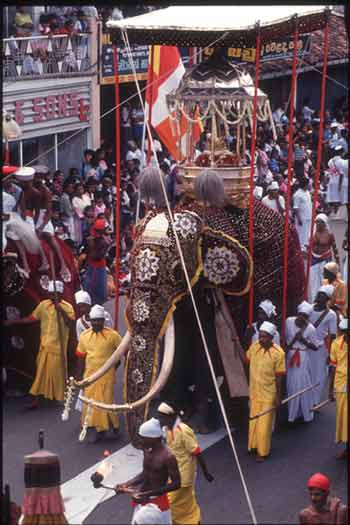
|
|||||||
|
| |||||||
Sri Dalada Perahera in the 19th Century
A contemporary poem ‘Dalada Alankaraya' describe the order of the procession and how the banners were marshalled. After the fall of Kandy on March 2nd, 1815 General Sir Robert Brownrigg Bert held a Perahara a mile long on May 3rd, 1815 which well nigh rivalled the processions of the Kandyan monarchs. A new feature added to the procession was the personnel of the Ceylon Rifle Regiment with their drums being played on western notations. In this mile long procession, the place of the King was taken by ex-Prime Minister Ehelepola. The event is commemorated in the ‘Dalada Pujavaliya' and ‘Dalada Siritha', a compendium of the former. Again on May 28th, 1828 Governor Sir Edward Barnes organised a Perahera in Kandy to transfer the Sacred Tooth Relic from the British government to that of the Kandyan chiefs. The celebration was elaborately arranged according to ancient customs and magnificently carried out. Buddhists from all parts of the island attended and by the command of the Governor low country chiefs for the first time too participated in the pageant along with the Kandyan chiefs. From the earliest times banners were carried in religious and royal processions in ancient Sri Lanka. This was especially the case in Perahara escorting the Sacred Tooth and Bowl Relics and those connected with the worship of the devales. These Perahara or religious pageants held at the capital were great national institutions patronised by the kings to display their power and magnificence to their subjects as much as to honour the Relics and worship the Gods. Thus in the festivals as well as in war there is little doubt that in addition to the standards of the god-kings the banners of the princes, provinces and departments of the realm were carried. The banners and standards borne before the procession were: The Buddhist flag, Sinhala Rajakeeya Dajaya (Sinhalese Royal Flag) having the figure of a lion holding a sword. In the mile long procession the place of the Sinhalese king was taken by the ex-Prime Minister Ehelepola. The Perahara was headed by eighty gaily caparisoned huge tuskers attended by a number of personnel. Immediately following the tuskers were the Mahanayaha Theras of Malwatte and Asgiriya accompanied by two young monks. Following them were one hundred and fifty monks according to their seniority of ordination moving in a single file. Behind them an image of Lord Buddha was carried under a canopy followed by sixty men carrying sixty banners of different hue and colour. The dancing girls, conch-shell blowers and drummers had their places in the procession. The first Adigar Molligoda and chiefs of the Kandyan nobility in full, ceremonial attire were headed by whip-crackers making an unbroken ear-splitting cracking. They were followed by two hundred principal Headmen in full state attire. Next came men marching with guns and cannons hauled along. A new feature added to the procession was the personnel of the Ceylon Rifle Regiment with their drums being played on western notations. Just behind the soldiers was a huge tusker gaily decorated moving majestically with a ‘ranhiligey' or ‘karanduwa' where it was deposited the Sacred Tooth Relic with two other tuskers on either side. Following other chieftains in Kandyan attire was John D'Oyley, Chief Commissioner of the Kandyan Provinces, who was Governor's representative. They were following by six more elephants on whose back were mounted Sacred images. Ehelepola, ex-Prime Minister took the place of the King. He rode on horse back last in the procession clad in a beautifully ornamented Kandyan dress. The Perahara arrived at the Temple of the Sacred Tooth Relic at 4.00 p.m. and as the time was inauspicious to enter the Temple and therefore, had to move again around the Grand Square till the time considered propitious. Then the guns fired a salute by the Royal Artillery of the Garrison. After the Sacred Tooth Relic was taken into the Temple the Governor's representative D'Oyley declared before the Maha Nayake Theras that he was making an offering of a beautifully finished musical clock on the orders of the Governor Robert Brownrigg. Since the British occupied Kandy, a Board of Commissioners were appointed as custodians of the Sacred Tooth Relic because the last King of Kandy Sri Wickrema Rajasinha abandoned the capital in the face of the British attack. The Relic Chamber of the Temple of the Tooth was carefully and jealously guarded by a British sentry at all times. The keys of the Chamber as well as the caskets were added to the official property of the Government Agent of Kandy. Thirteen years after the first Perahara by the Britishers, the second Perahara was held on May 28th, 1828 to transfer the Sacred Tooth Relic from the custody of the British government to that of the Kandyan chiefs. The celebrations was elaborately arranged according to ancient customs and magnificently carried out. In the Perahera the then Governor Sir Edward and Lady Barnes participated in the Perahara and went in the procession in a palanquin. ‘The Times of Ceylon' of April 15th, 1901 gives the following account:
by M. B. Dassanayake
|
